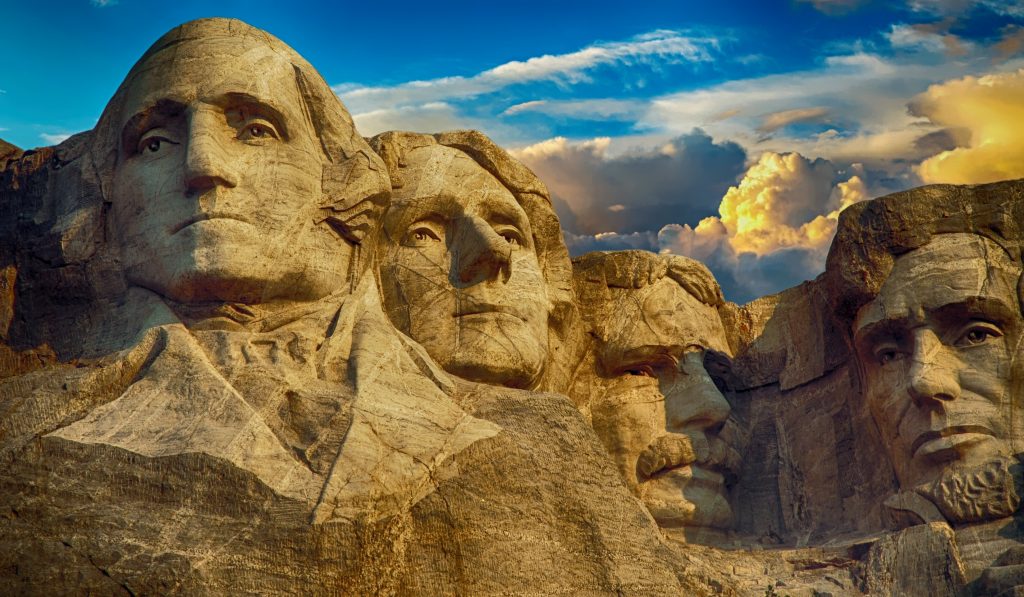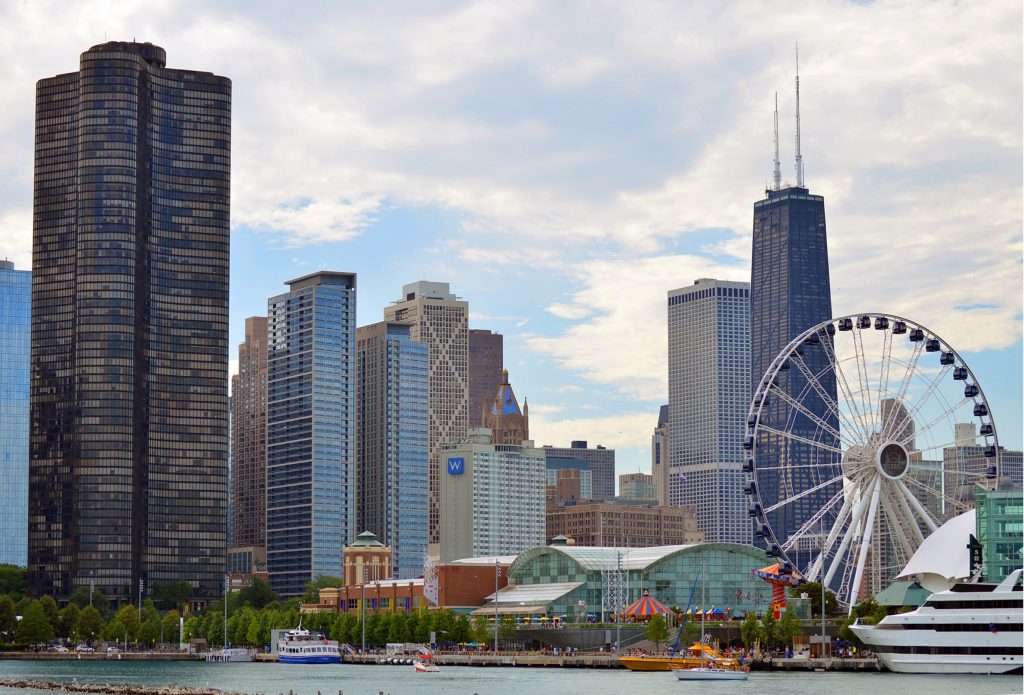OVERVIEW
Throughout its history, the United States has been a nation of immigrants. The population is diverse with people from all over the world seeking refuge and a better way of life.
The country is divided into six regions: New England, the mid-Atlantic, the South, the Midwest, the Southwest, and the West. European settlers came to New England in search of religious freedom. These states are Connecticut, Maine, Massachusetts, New Hampshire, Rhode Island, and Vermont.
The mid-Atlantic region includes Delaware, Maryland, New Jersey, New York, Pennsylvania, and the city of Washington, D.C. These industrial areas attracted millions of European immigrants and gave rise to some of the East Coast’s largest cities: New York, Baltimore, and Philadelphia.
The South includes Alabama, Arkansas, Florida, Georgia, Kentucky, Louisiana, Mississippi, North Carolina, South Carolina, Tennessee, Virginia, and West Virginia, all of which struggled after the Civil War, which lasted from 1860-1865.
The Midwest is home to the country’s agricultural base and is called the “nation’s breadbasket.” The region comprises the states of Illinois, Indiana, Iowa, Kansas, Michigan, Minnesota, Missouri, Nebraska, North Dakota, Ohio, South Dakota, and Wisconsin.
The Southwest is a beautiful stark landscape of prairie and desert. The states of Arizona, New Mexico, Oklahoma, and Texas are considered the Southwest and are home to some of the world’s great natural marvels, including the Grand Canyon and Carlsbad Caverns.
The American West, home of rolling plains and the cowboy, is a symbol of the pioneering spirit of the United States. The West is diverse, ranging from endless wilderness to barren desert, coral reefs to Arctic tundra, Hollywood to Yellowstone. The states of the West include Alaska, Colorado, California, Hawaii, Idaho, Montana, Nevada, Oregon, Utah, Washington, and Wyoming
The landscape varies across the large country from tropical beaches in Florida to peaks in the Rocky Mountains, from rolling prairie lands and barren deserts in the West to dense wilderness areas in the Northeast and Northwest. Interspersed throughout are the Great Lakes, the Grand Canyon, the majestic Yosemite Valley, and the mighty Mississippi River.
The wildlife is as diverse as the landscape. Mammals such as bison once roamed freely across the plains, but now live only in preserves. Black bears, grizzlies, and polar bears are the largest carnivores. There are over 20,000 flower species and most came from Europe. There are more than 400 areas which are protected and maintained by the National Park Service, and many other parks in each state.
The bald eagle is the national bird and symbol of the United States and is a protected species.
Throughout its history, the United States has been a nation of immigrants. The population is diverse with people from all over the world seeking refuge and a better way of life.
The country is divided into six regions: New England, the mid-Atlantic, the South, the Midwest, the Southwest, and the West. European settlers came to New England in search of religious freedom. These states are Connecticut, Maine, Massachusetts, New Hampshire, Rhode Island, and Vermont.
The mid-Atlantic region includes Delaware, Maryland, New Jersey, New York, Pennsylvania, and the city of Washington, D.C. These industrial areas attracted millions of European immigrants and gave rise to some of the East Coast’s largest cities: New York, Baltimore, and Philadelphia.
The South includes Alabama, Arkansas, Florida, Georgia, Kentucky, Louisiana, Mississippi, North Carolina, South Carolina, Tennessee, Virginia, and West Virginia, all of which struggled after the Civil War, which lasted from 1860-1865.
The Midwest is home to the country’s agricultural base and is called the “nation’s breadbasket.” The region comprises the states of Illinois, Indiana, Iowa, Kansas, Michigan, Minnesota, Missouri, Nebraska, North Dakota, Ohio, South Dakota, and Wisconsin.
The Southwest is a beautiful stark landscape of prairie and desert. The states of Arizona, New Mexico, Oklahoma, and Texas are considered the Southwest and are home to some of the world’s great natural marvels, including the Grand Canyon and Carlsbad Caverns.
The American West, home of rolling plains and the cowboy, is a symbol of the pioneering spirit of the United States. The West is diverse, ranging from endless wilderness to barren desert, coral reefs to Arctic tundra, Hollywood to Yellowstone. The states of the West include Alaska, Colorado, California, Hawaii, Idaho, Montana, Nevada, Oregon, Utah, Washington, and Wyoming
The landscape varies across the large country from tropical beaches in Florida to peaks in the Rocky Mountains, from rolling prairie lands and barren deserts in the West to dense wilderness areas in the Northeast and Northwest. Interspersed throughout are the Great Lakes, the Grand Canyon, the majestic Yosemite Valley, and the mighty Mississippi River.
The wildlife is as diverse as the landscape. Mammals such as bison once roamed freely across the plains, but now live only in preserves. Black bears, grizzlies, and polar bears are the largest carnivores. There are over 20,000 flower species and most came from Europe. There are more than 400 areas which are protected and maintained by the National Park Service, and many other parks in each state.
The bald eagle is the national bird and symbol of the United States and is a protected species.
EDUCATION
Study in the USA
The USA has the world’s largest international student population, with more than 1,000,000 students choosing to broaden their education and life experience in the United States. Nearly 5% of all students enrolled in higher-level education in the USA are international students, and the numbers are growing. From the mid-1950’s, when international student enrollment was only just reaching 35,000, international education in the USA has come a long way.
We look forward to helping students like you who are considering continuing education in the United States. You will find all the tools you need to compile your necessary research in deciding if the United States is the best place for you — we have gathered valuable information on educational, social, cultural and economic aspects of studying in the U.S
Choosing the USA
There are many reasons that students like to come to the USA to study at the undergraduate and graduate level
Every year, the number of international students in the US rises as more and more students choose the Unites States as the place they wanted to broaden their experience and continue their education. In fact, the US is now the most popular country for international students. Why do so many international students choose U.S. colleges and universities?
Before you pack your bags, you should learn what the U.S. has to offer you
Academic Excellence
The United States has one of the world’s finest university systems, with outstanding programs in virtually all fields. At the undergraduate level, excellent programs exist in traditional disciplines, as well as in professional fields. At the graduate level, students have the opportunity to work directly with some of the finest minds in their field of study, with the chance to become involved with exclusive research and educational opportunities. U.S. degrees are recognized throughout the world for their excellence.
Variety of Educational Opportunities
The United States is home to several thousand colleges and universities, boasting at least ten times as many campuses as in any other country. As a result, the higher education system in the U.S. has something for everyone. Some U.S. colleges and universities stress broad educational principles; others emphasize practical, employment-related skills; and still others specialize in the arts, social sciences or technical fields. This means that no matter what you plan on studying, you will have a wide variety of programs in your particular field from which to choose.
Cutting-Edge Technology
Universities in the U.S. pride themselves on being at the forefront of technology, research and techniques, and in making the best possible equipment and resources available to their students. Even if your field does not directly involve science or engineering, you will have opportunities to become skilled in using the latest technology to conduct research, as well as obtain and process information. You will find ways to stay connected with researchers, teachers and experts in your field all over the world.
Opportunity for Research, Teaching and Training
You may be able to gain valuable experience through teaching and/or research while you help to finance your education in the U.S., particularly if you are a graduate student. Many graduate programs offer training and teaching opportunities that enable students to become teaching assistants to undergraduates and/or research assistants on special projects exploring different aspects of your field of study.
International students are some of the most valued teachers and researchers in U.S. universities because they bring new skills and ideas to the classroom and library or laboratory. This practical component of your education will prove useful in your future career, and may give you insights into your field that would not be possible through course study alone.
Flexibility
Although many programs are highly structured in that specific coursework requirements must be met, you will generally be able to find a wide variety of course choices to meet those requirements. For example, liberal arts coursework for an undergraduate program will include classes in languages and mathematics, but you will be given a wide variety of classes which fit those requirements, and the freedom to decide which classes best match your interests.
At the advanced stages of a degree, or if you are pursuing a graduate degree, you will be able to tailor your coursework to fit your specific academic goals, needs and interests. When you choose topics for independent study for a graduate thesis or dissertation, you can emphasize ideas that are important to you, your field and your country.
Support Services for International Students
Studying in the United States is a rewarding experience, but navigating your way through day-to-day issues can be a challenge. Many international students find that the college and university international student office is a great resource when it comes to adapting to a culturally and academically different environment. The mission of the international student office is to assist students like you, and there is often a wide range of student services that they provide
An orientation program upon your arrival is just the start of the many programs and benefits of the university international student office – throughout your time in the U.S., they can help answer questions you may have regarding your visa status, financial situation, housing, employment possibilities, health concerns and more. If you choose to complete your degree in the United States, this office often provides resume and employment assistance as graduation nears. The international student office will be an invaluable source of information and help as you make the transition into academic and cultural life in the United States.
Global Education and Long-Term Career Prospects
Experience in an international setting is a marketable commodity. Many employers seek the wide range of knowledge, adaptability and experience that international students acquire by studying in the United States. Companies in the U.S. are increasingly seeking to become a strong presence in the global marketplace. They often look to hire employees who not only have multi-cultural language skills, but those who can also help communicate, negotiate and conduct business across different cultures.
The United States is not the only country seeking strong candidates when hiring; international students are in high demand elsewhere, as well. In recent years, international companies have become much more proactive in recruiting from the pool of strong international student graduates. Your long-term career prospects can be enhanced by your experiences through the development of self-confidence, independence and cross-cultural skills – attributes which are in high demand with employers worldwide.
Campus Life Experience
When you continue your studies in the U.S., you are making a choice to broaden not only your educational opportunities, but your cultural experience, as well. Whether you attend a small, private college in a small town or a university situated in the middle of a large urban area, most universities offer a variety of student clubs and organizations to match the wide array of student interests. You can have the opportunity to immerse yourself in American culture, meeting new people and making new friends, through different organizations and associations.
International students often find that the international student office is a good starting point for campus offerings, as well as the campus student center. Your time studying abroad can be enriched by taking part in the social and cultural scene surrounding you, and you will likely find that U.S. campuses provide a rich variety academic, cultural and athletic activities that add new dimensions to your life.
Preparation for your stay
All the necessities of life that you have at home, you will have to recreate for your stay in the USA. Do you have your student visa, travel essentials and enough cash to get set up? Have you purchased an international student insurance plan? Are you set up to call home regularly and affordably? Make sure you are fully prepared before you leave for the USA.
Getting into a US College or University
Trying to become an international student inside the US is not easy. The application process is complex and competitive which means it requires hard work and dedication before classes even start. Additionally, it’s not a quick process; students should start preparing months in advance and need to stay organized and informed throughout. We have created a guide to getting into a US college or university to help you navigate through each step and provide you with tips along the way.
VISA INFORMATION
As an international student coming to the United States, there are three different student visas that you could be issued: F1 Visa, J1 Visa or M1 Visa. The F1 and J1 visas allow for the possibility of employment in the US during your stay, while the M1 Visa does not. You need to be familiar with the types of visas, how they impact your financing while in the USA and how to go through the application and arrival processes.
Types of International Student Visas
F1 Visa:
Academic Studies
The “F” visa is for academic studies. An F1 visa is issued to students who are attending an academic program or English Language Program. F1 visas are by far the most common form of international student visa in the U.S. F1 students must maintain the minimum course load for full-time student status. F1 status allows for part-time, on-campus employment (fewer than 20 hours per week). Additionally, students can work on optional practical training (OPT) for up to one year after completion of their academic program. Students are expected to complete their studies by the expiration date on the I-20 form (Certificate of Eligibility for Nonimmigrant Student Status).
Learn more about the F1 Student Visa
J1 Visa:
Practical Training
A J1 visa is issued to students who need to obtain practical training that is not available in their home country to complete their academic program. J-1 student status allows for similar employment as the F1 visa, with similar restrictions, as long as permission is given by the exchange visitor program sponsor.
Learn more about the J1 Student Visa
M1 Visa:
Non-Academic /
Vocational Studies
An M1 visa is issued to a student who is going to attend a non-academic or vocational school. M-1 visa holders for technical and vocational programs are not permitted to work during the course of their studies. The M-1 student visa applicants must have evidence that sufficient funds are immediately available to pay all tuition and living costs for the entire period of intended stay.
Living with your Student Visa in the USA
As you begin to think about funding sources for your educational and living expenses in the United States, remember that you cannot count on working in the United States unless you have been granted a teaching or research assistantship. Immigration regulations are very strict with respect to working while carrying a student visa, and when you submit evidence of your financial resources, you cannot rely on potential income. The income on which you base your application must be assured, and it must be equal to or exceed the costs of the first year of your studies.
Careful long-term and short-term planning is necessary to ensure that you will have a rewarding educational experience in the United States. If you are realistic about your financial needs, you will be better able to enjoy the exciting academic and cultural experience of living and learning in the United States.
Applying for your Visa
When putting together your application for a student visa, you will first need to research the admission policy for your university. Keep the following items in mind:
Academic Eligibility
Every school has different academic eligibility criteria. Your school will tell you what their requirements are. If you are still in the process of researching different schools, you can use the USA School Search to research general academic standing and test scores.
Financial Stability
You will need to show that you can support yourself without having to work.
Health Insurance
You may have to show proof of health insurance in order to cover any medical expenses should you need any medical assistance.









